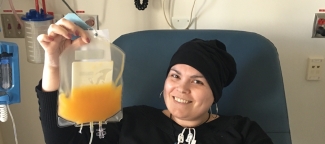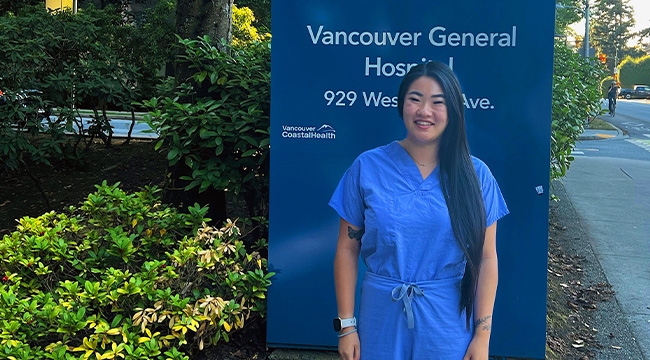The need goes on #4: Stem cells to save a life
She’s still alive thanks to the generosity of stem cell, blood and plasma donors.
Tania Grim was a 34-year-old mother of four when she received her diagnosis. She’d spent months trying to find out what was wrong.
“I couldn’t eat, I couldn’t walk, and I told my doctor if they didn’t admit me to the hospital, I was going to die,” she said.
Tania had myelodysplastic syndrome, a type of cancer in which the stem cells in her bone marrow weren’t making enough healthy blood cells. She spent a month at a Vancouver hospital receiving chemotherapy and many units of blood and platelets. From there, her search for a stem cell match began.
Because Tania had been pregnant multiple times, her blood carried many antibodies, and her health care team feared an immune response could kill off the new stem cells before they had a chance to help.
She’d seen this happen before with platelets. There was a specific donor whose platelets were compatible with Tania’s, and this donor would be called to donate when Tania’s platelet counts dropped.
The search involved many potential donors, including Tania’s brother, and at least one false start, when a person who appeared to be the ideal match declined to proceed with the donation. “It was devastating,” Tania says. “It might have been my only chance. And it was a matter of life and death.”
Eventually, a suitable match was found — less ideal, but close enough to start planning the transplant. Tania had to go through a medical protocol to reduce the antibodies in her blood. She needed more chemotherapy and plasmapheresis. As a precaution, her health-care team collected her own stem cells so that if the transplant failed, she could have a bit more time with her family.
Finally Sept. 13, 2017, arrived — the day when Tania received lifesaving stem cells from a donor in Germany.
“It was a brutal experience. I received a lot of blood and platelets while we waited to see whether the transplant would work. I was at the hospital every day for months,” she says.
Shortly after the transplant, she began using immuneglobulin, a plasma-derived therapy that supports her ravaged immune system. Now, Tania’s taking it one day at a time. In November 2019, she was healthy enough to begin volunteering at Canadian Blood Services’ donor centres, and will soon be volunteering at stem cell donor recruitment events. She has just returned to work part-time

The need for stem cells goes on
Every year, hundreds of patients in Canada need a lifesaving stem cell transplant to treat blood cancers and disorders such as leukemia, lymphoma, aplastic anemia, and inherited immune and metabolic disorders. Most rely on the generosity of an unrelated donor.
“Canadian Blood Services tells all new registrants that joining the stem cell registry means they are making a long-term commitment, sometimes for years, and the call to donate could come any time. Even so, about half of those contacted to launch the actual donation process decline to proceed,” says Dr. Heidi Elmoazzen, director of stem cells at Canadian Blood Services. “This is obviously potentially devastating for the patient.”
Potential donors are free to decline to donate at any point in the process. The later in the process, however, the greater the risk to the patient. If a would-be donor decides to withdraw after the patient has started radiation or chemotherapy treatment in preparation for the transplant, the patient faces a real risk of dying.
Who’s the ideal stem cell donor? We’re especially interested in male donors between the ages of 17 and 35, since their donations tend to result in better outcomes for patients. We’re also looking for donors from all kinds of ancestral backgrounds, because patients of diverse ethnic or mixed-race backgrounds often face more difficulty in finding a donor, and we want to change that. For example, patients of European descent have a 75 per cent chance of finding an optimal donor, whereas patients of black African descent have only a 16 per cent chance. The first step in saving a life can be as easy as joining Canadian Blood Services Stem Cell Registry online — the public registry responsible for finding and recruiting healthy, committed volunteer donors.
When Tania volunteers in donor centres, she keeps an eye out for younger donors.
“I ask them if they know about the stem cell registry and share what it meant for me that my donor made the choice to register,” she says.
The risk of COVID-19 is prompting people across Canada to avoid public spaces of all kinds. However, the need for committed donors continues, and our donor centres continue to be safe places to visit with appropriate social distancing measures in place. Our website is updated daily with information about our own response to COVID-19 including our measures to keep donors safe. To make an appointment you can download the GiveBlood app, call 1 888 2 DONATE (1-888-236-6283) or book now at blood.ca.



